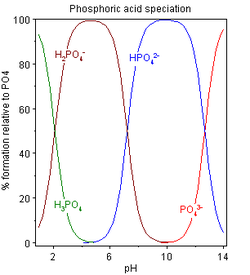- Phosphate
-
Phosphate 
 Systematic namePhosphate[1]
Systematic namePhosphate[1]Identifiers CAS number 14265-44-2 
PubChem 1061 ChemSpider 1032 
UNII NK08V8K8HR 
MeSH Phosphates ChEBI CHEBI:18367 
ChEMBL CHEMBL289287 
Beilstein Reference 3903772 Gmelin Reference 1997 Jmol-3D images Image 1
Image 2
Image 3- [O-]P([O-])([O-])=O
[O-]P(=O)([O-])[O-]
O=P([O-])([O-])[O-]
Properties Molecular formula PO43- Molar mass 94.9714 g mol−1 Exact mass 94.953420000 g mol−1  (verify) (what is:
(verify) (what is:  /
/ ?)
?)
Except where noted otherwise, data are given for materials in their standard state (at 25 °C, 100 kPa)Infobox references A phosphate, an inorganic chemical, is a salt of phosphoric acid. In organic chemistry, a phosphate, or organophosphate, is an ester of phosphoric acid. Organic phosphates are important in biochemistry and biogeochemistry or ecology. Inorganic phosphates are mined to obtain phosphorus for use in agriculture and industry.[2][3][4] At elevated temperatures in the solid state, phosphates can condense to form pyrophosphates.
Contents
Chemical properties
 This is the structural formula of the phosphoric acid functional group as found in a weakly acidic aqueous solution. In more basic aqueous solutions, the group donates the two hydrogen atoms and ionizes as a phosphate group with a negative charge of 2. [5]
This is the structural formula of the phosphoric acid functional group as found in a weakly acidic aqueous solution. In more basic aqueous solutions, the group donates the two hydrogen atoms and ionizes as a phosphate group with a negative charge of 2. [5]
The phosphate ion is a polyatomic ion with the empirical formula PO3−
4 and a molar mass of 94.97 g/mol. It consists of one central phosphorus atom surrounded by four oxygen atoms in a tetrahedral arrangement. The phosphate ion carries a negative three formal charge and is the conjugate base of the hydrogen phosphate ion, HPO2−
4, which is the conjugate base of H2PO−
4, the dihydrogen phosphate ion, which in turn is the conjugate base of H3PO4, phosphoric acid. The phosphate ion is a hypervalent molecule (the phosphorus atom has 10 electrons in its valence shell). A phosphate salt forms when a positively charged ion attaches to the negatively charged oxygen atoms of the ion, forming an ionic compound. Many phosphates are not soluble in water at standard temperature and pressure. The sodium, potassium, rubidium, caesium and ammonium phosphates are all water soluble. Most other phosphates are only slightly soluble or are insoluble in water. As a rule, the hydrogen and dihydrogen phosphates are slightly more soluble than the corresponding phosphates. The pyrophosphates are mostly water soluble.Aqueous phosphate exists in four forms. In strongly basic conditions, the phosphate ion (PO3−
4) predominates, whereas in weakly basic conditions, the hydrogen phosphate ion (HPO2−
4) is prevalent. In weakly acid conditions, the dihydrogen phosphate ion (H2PO−
4) is most common. In strongly acidic conditions, trihydrogen phosphate (H3PO4) is the main form.More precisely, considering the following three equilibrium reactions:
the corresponding constants at 25°C (in mol/L) are (see phosphoric acid):
![K_{a1}=\frac{[\mbox{H}^+][\mbox{H}_2\mbox{PO}_4^-]}{[\mbox{H}_3\mbox{PO}_4]}\simeq 7.5\times10^{-3}](9/e699884edcac6d95070a845c0c762a2d.png) (pKa1 2.12)
(pKa1 2.12)
![K_{a2}=\frac{[\mbox{H}^+][\mbox{HPO}_4^{2-}]}{[\mbox{H}_2\mbox{PO}_4^-]}\simeq 6.2\times10^{-8}](6/466635c0bdeda7b6835c81ed05521c58.png) (pKa2 7.21)
(pKa2 7.21)![K_{a3}=\frac{[\mbox{H}^+][\mbox{PO}_4^{3-}]}{[\mbox{HPO}_4^{2-}]}\simeq 2.14\times10^{-13}](c/5cc79605352c42f338e007c5d4c32db1.png) (pKa3 12.67)
(pKa3 12.67)
The speciation diagram obtained using these pK values shows three distinct regions. In effect H3PO4, H2PO−
4 and HPO2−
4 behave as separate weak acids. This is because the successive pK values differ by more than 4. For each acid the pH at half-neutralization is equal to the pK value of the acid. The region in which the acid is in equilibrium with its conjugate base is defined by pH ≈ pK ± 2. Thus the three pH regions are approximately 0–4, 5–9 and 10–14. This is idealized as it assumes constant ionic strength, which will not hold in reality at very low and very high pH values.For a neutral pH as in the cytosol, pH=7.0
so that only H2PO−
4 and HPO2−
4 ions are present in significant amounts (62% H2PO−
4, 38% HPO2−
4 Note that in the extracellular fluid (pH=7.4), this proportion is inverted (61% HPO2−
4, 39% H2PO−
4).Phosphate can form many polymeric ions such as diphosphate (also known as pyrophosphate), P2O4−
7, and triphosphate, P3O5−
10. The various metaphosphate ions (which are usually long linear polymers) have an empirical formula of PO−
3 and are found in many compounds.Biochemistry of phosphates
In biological systems, phosphorus is found as a free phosphate ion in solution and is called inorganic phosphate, to distinguish it from phosphates bound in various phosphate esters. Inorganic phosphate is generally denoted Pi and at physiological (neutral) pH primarily consists of a mixture of HPO2−
4 and H2PO−
4 ions.Inorganic phosphate can be created by the hydrolysis of pyrophosphate, which is denoted PPi:
However, phosphates are most commonly found in the form of adenosine phosphates, (AMP, ADP and ATP) and in DNA and RNA and can be released by the hydrolysis of ATP or ADP. Similar reactions exist for the other nucleoside diphosphates and triphosphates. Phosphoanhydride bonds in ADP and ATP, or other nucleoside diphosphates and triphosphates, contain high amounts of energy which give them their vital role in all living organisms. They are generally referred to as high energy phosphate, as are the phosphagens in muscle tissue. Compounds such as substituted phosphines have uses in organic chemistry but do not seem to have any natural counterparts.
The addition and removal of phosphate from proteins in all cells is a pivotal strategy in the regulation of metabolic processes.
Reference ranges for blood tests, showing inorganic phosphorus in purple at right, being almost identical to the molar concentration of phosphate.
Phosphate is useful in animal cells as a buffering agent. Phosphate salts that are commonly used for preparing buffer solutions at cell pHs include Na2HPO4, NaH2PO4, and the corresponding potassium salts.
An important occurrence of phosphates in biological systems is as the structural material of bone and teeth. These structures are made of crystalline calcium phosphate in the form of hydroxyapatite. The hard dense enamel of mammalian teeth consists of fluoroapatite, an hydroxy calcium phosphate where some of the hydroxyl groups have been replaced by fluoride ions.
Insect exoskeleta are constructed of chitin containing crystalline calcium phosphate as a strengthening material.
Geochemistry of phosphates
Phosphates are the naturally occurring form of the element phosphorus, found in many phosphate minerals. In mineralogy and geology, phosphate refers to a rock or ore containing phosphate ions. Inorganic phosphates are mined to obtain phosphorus for use in agriculture and industry.[2][3][4]
The largest phosphorite or rock phosphate deposits in North America lie in the Bone Valley region of central Florida, United States, the Soda Springs region of Idaho, and the coast of North Carolina. Smaller deposits are located in Montana, Tennessee, Georgia and South Carolina near Charleston along Ashley Phosphate road. The small island nation of Nauru and its neighbor Banaba Island, which used to have massive phosphate deposits of the best quality, have been mined excessively. Rock phosphate can also be found in Egypt, Israel, Morocco, Navassa Island, Tunisia, Togo and Jordan, countries that have large phosphate mining industries.
Phosphorite mines are primarily found in:
- North America: United States of America, especially North Carolina, with lesser deposits in Florida, Idaho and Tennessee.
- Africa: Morocco, mainly near Khouribga and Youssoufia; Senegal, Togo, Tunisia and Western Sahara.
- Middle East: Israel, Saudi Arabia, Jordan, Iraq, at the town of Akashat, near to the Jordanian borders.
- Oceania: Australia, Makatea, Nauru, Banaba Island.
In 2007, at the current rate of consumption, the supply of phosphorus was estimated to run out in 345 years.[6] However, some scientists now believe that a "Peak phosphorus" will occur in 30 years and that "At current rates, reserves will be depleted in the next 50 to 100 years."[7]
Some phosphate rock deposits are notable for their inclusion of significant quantities of radioactive uranium isotopes. This syndrome is noteworthy because radioactivity can be released into surface waters[8] in the process of application of the resultant phosphate fertilizer (e.g. in many tobacco farming operations in the southeast USA).
Ecology of phosphates
In ecological terms, because of its important role in biological systems, phosphate is a highly sought after resource. Once used, it is often a limiting nutrient in environments, and its availability may govern the rate of growth of organisms. This is generally true of freshwater environments, whereas nitrogen is more often the limiting nutrient in marine (seawater) environments. Addition of high levels of phosphate to environments and to micro-environments in which it is typically rare can have significant ecological consequences. For example, blooms in the populations of some organisms at the expense of others, and the collapse of populations deprived of resources such as oxygen (see eutrophication) can occur. In the context of pollution, phosphates are one component of total dissolved solids, a major indicator of water quality.
Calcium hydroxyapatite and calcite precipitates can be found around bacteria in alluvial topsoil.[9] As clay minerals promote biomineralization, the presence of bacteria and clay minerals resulted in calcium hydroxyapatite and calcite precipitates.[9]
Phosphate deposits can contain significant amounts of naturally occurring heavy metals. Mining operations processing phosphate rock can leave tailings piles containing elevated levels of cadmium, lead, nickel, copper, chromium, and uranium. Unless carefully managed, these waste products can leach heavy metals into groundwater or nearby estuaries. Uptake of these substances by plants and marine life can lead to concentration of toxic heavy metals in food products.[10]
See also
- Hypophosphite – H2PO2-
- Organophosphorus compounds
- Phosphate conversion coating
- Phosphine – PR3
- Phosphine oxide – OPR3
- Phosphinite – P(OR)R2
- Phosphonite – P(OR)2R
- Phosphite – P(OR)3
- Phosphinate – OP(OR)R2
- Phosphonate – OP(OR)2R
- Phosphate — OP(OR)3, such as triphenyl phosphate
- Polyphosphate – PnO3n+1(n+2)-
- Phosphorylation
- Pyrophosphate – P2O74-
- Phosphorus oxoacids
- Phosphate homeostasis
- Phosphogypsum
- Fertilizer
References
- ^ "Phosphates – PubChem Public Chemical Database". The PubChem Project. USA: National Center of Biotechnology Information. http://pubchem.ncbi.nlm.nih.gov/summary/summary.cgi?cid=1061&loc=ec_rcs.
- ^ a b "Phosphate Primer". http://fipr1.state.fl.us/PhosphatePrimer.
- ^ a b Lynn A. Kuntz (June 2006). "Figuring Out Phosphates". http://www.foodproductdesign.com/articles/661ingredient2.html.
- ^ a b Lynn A. Kuntz (June 2006). "Food Product Design". http://www.foodproductdesign.com/articles/661ingredient2.html.
- ^ Campbell, Neil A.; Reece, Jane B. (2005). Biology (Seventh ed.). San Francisco, California: Benjamin Cummings. pp. 65. ISBN 0-8053-7171-0.
- ^ "How Long Will it Last?". New Scientist 194 (2605): 38–9. May 26, 2007. doi:10.1016/S0262-4079(07)61508-5. ISSN 4079 0262 4079.
- ^ Leo Lewis (2008-06-23). "Scientists warn of lack of vital phosphorus as biofuels raise demand". The Times. http://business.timesonline.co.uk/tol/business/industry_sectors/natural_resources/article4193017.ece.
- ^ C.Michael Hogan. 2010. Water pollution. Encyclopedia of Earth. eds. Mark McGinley and C. Cleveland. National Council for Science and the Environment. Washington DC.
- ^ a b Schmittner KE, Giresse P (1999). "Micro-environmental controls on biomineralization: superficial processes of apatite and calcite precipitation in Quaternary soils, Roussillon, France". Sedimentology 46 (3): 463–76. doi:10.1046/j.1365-3091.1999.00224.x.
- ^ Gnandil, K.; Tchangbedjil, G.; Killil, K.; Babal, G.; Abbel, E. (March). "The Impact of Phosphate Mine Tailings on the Bioaccumulation of Heavy Metals in Marine Fish and Crustaceans from the Coastal Zone of Togo". Mine Water and the Environment 25 (1): 56–62. doi:10.1007/s10230-006-0108-4.
External links
- US Minerals Databrowser provides data graphics covering consumption, production, imports, exports and price for phosphate and 86 other minerals
- Taking Stock of Phosphorus and Biofuels, global phosphate mining, use and shortages.
Categories:- Functional groups
- Organophosphates
- Phosphorus oxoanions
- Phosphates
- [O-]P([O-])([O-])=O
Wikimedia Foundation. 2010.







![\frac{[\mbox{H}_2\mbox{PO}_4^-]}{[\mbox{H}_3\mbox{PO}_4]}\simeq 7.5\times10^4 \mbox{ , }\frac{[\mbox{HPO}_4^{2-}]}{[\mbox{H}_2\mbox{PO}_4^-]}\simeq 0.62 \mbox{ , } \frac{[\mbox{PO}_4^{3-}]}{[\mbox{HPO}_4^{2-}]}\simeq 2.14\times10^{-6}](9/d5974fad8b424a36ef554a11bfe2243c.png)
